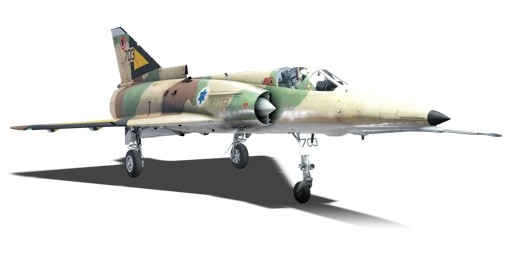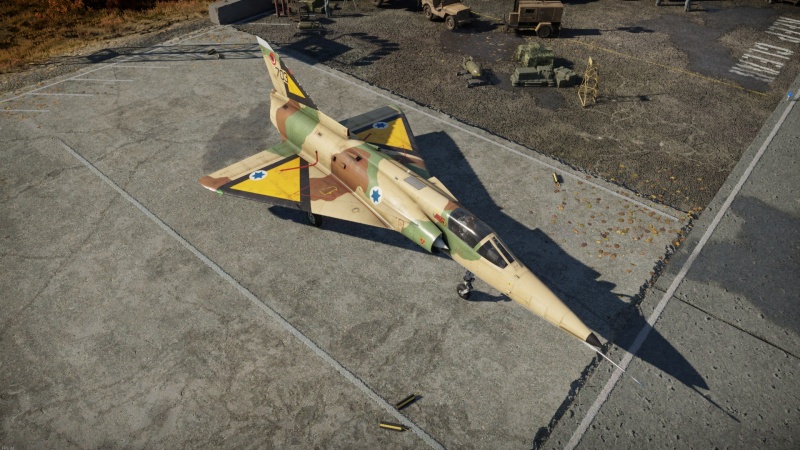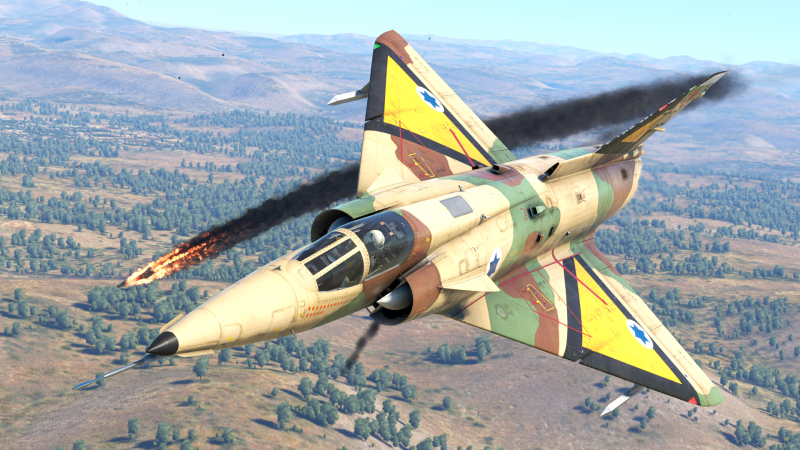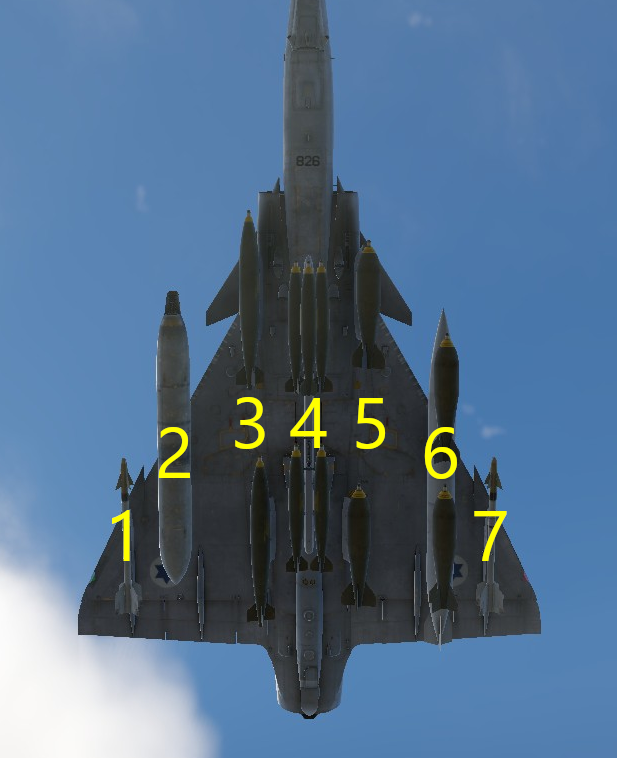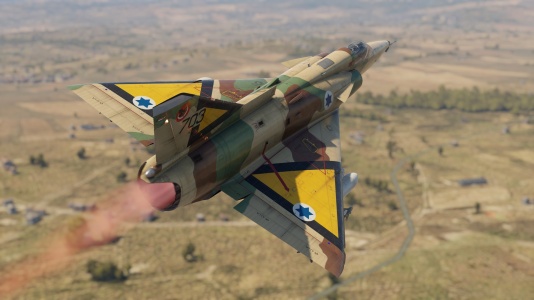Kfir Canard
| This page is about the premium Israeli jet fighter Kfir Canard. For other versions, see Mirage 5 (Family). |
Contents
Description
The Kfir Canard, known as the F-21A/Kfir Gderot (Kfir C.1) in US/Israeli service, was the first series of the IAI Kfir (Lion Cub) and the earliest domestic-designed jet built in Israel. After the domestic production of Nesher (Mirage 5) by IAI, there were further plans to upgrade Nesher's underpowered engine with a GE J79 engine with much higher thrust, as well as some aerodynamic changes to fit the engine and for better overall capabilities. The new Kfir C.1 made its maiden flight in 1973 and soon joined IAF by the next year as one of the frontline fighters of IAF against neighboring Arabic countries and been rented by USN/USMC as their aggressive squadron's jet to simulate MiG-23S. As new Kfir series and US jets entered service, Kfir C.1 was soon withdrawn from IAF service.
Introduced in Update "Apex Predators" as one of the gift premiums of Israel tech tree, Kfir Canard looks extremely like its technological predecessor, the Nesher; based on the Dassault Mirage 5, but with a pair of fixed canards bolted onto the the sides of the air intake. It might somehow make it look like the later Mirage 2000, but it has an air-to-air armament inferior to its enemies and the combat limitations of delta-wing jets. For ground attack, the Kfir Canard still offers varieties of US bombs and rocket pods to make it effective against grouped targets.
General info
Flight performance
At first glance, the jet looks very similar to the French Mirage series and players might start to think about the tech-tree predecessor Nesher. However, closer inspection shows the major differences of the Kfir Canard over the Mirage 5/Nesher: a pitot tube, enlarged air intakes, a pair of canards on the intakes, a vertical stabilizer with a longer "spine" as well as a shorter tail. For players already used to the Nesher or Mirage IIICJ, they will quickly feel familiar to the Kfir. For new comers who are flying a delta-wing jet for the first time, they will have to keep in mind the traits of delta wing: high rate of climb, severely energy bleed under manoeuvre and rather high stall speed. But a good news for the Kfir series is the engine, due to the upgrade of engine from a SNECMA Atar into a GE J79-GE-17 with higher thrust, the overall acceleration and manoeuvring ability in sustained turns is better than its predecessors (the fixed canard performs inferior to later variants with larger control-canards when pulling high AoA). Always remember the traits of delta-wings and stick to boom-and-zoom attacks rather than turnfights (unless in dire or 1-vs-1).
| Characteristics | Max speed (km/h at 10,668 m) |
Max altitude (metres) |
Turn time (seconds) |
Rate of climb (metres/second) |
Take-off run (metres) | |||
|---|---|---|---|---|---|---|---|---|
| AB | RB | AB | RB | AB | RB | |||
| Stock | 2,304 | 2,254 | 16000 | 28.5 | 29.0 | 166.6 | 155.1 | 750 |
| Upgraded | 2,444 | 2,376 | 25.6 | 27.0 | 246.4 | 205.0 | ||
Details
| Features | |||||
|---|---|---|---|---|---|
| Combat flaps | Take-off flaps | Landing flaps | Air brakes | Arrestor gear | Drogue chute |
| X | X | X | ✓ | X | ✓ |
| Limits | ||||||
|---|---|---|---|---|---|---|
| Wings (km/h) | Gear (km/h) | Flaps (km/h) | Max Static G | |||
| Combat | Take-off | Landing | + | - | ||
| 1,460 | 426 | - | - | - | ~11 | ~4 |
| Optimal velocities (km/h) | |||
|---|---|---|---|
| Ailerons | Rudder | Elevators | Radiator |
| < 920 | < 750 | < 1,460 | - |
Engine performance
| Engine | Aircraft mass | |||||
|---|---|---|---|---|---|---|
| Engine name | Number | Basic mass | Wing loading (full fuel) | |||
| General Electric J79-GE-17 | 1 | 7,300 kg | 285 kg/m2 | |||
| Engine characteristics | Mass with fuel (no weapons load) | Max Gross Weight | ||||
| Weight (each) | Type | 8m fuel | 20m fuel | 27m fuel | ||
| 1,750 kg | Afterburning axial-flow turbojet | 8,055 kg | 9,082 kg | 9,818 kg | 13,893 kg | |
| Maximum engine thrust @ 0 m (RB/SB) | Thrust to weight ratio @ 0 m (WEP) | |||||
| Condition | 100% | WEP | 8m fuel | 20m fuel | 27m fuel | MGW |
| Stationary | 5,200 kgf | 8,154 kgf | 1.01 | 0.89 | 0.83 | 0.58 |
| Optimal | 5,366 kgf (1,460 km/h) |
10,978 kgf (1,200 - 1,400 km/h) |
1.36 | 1.20 | 1.12 | 0.79 |
Survivability and armour
The Kfir Canard relies upon not being hit to be effective, largely achieved through its phenomenal acceleration, sharp but brief manoeuvring capability, and level flight speed. The Kfir Canard features no armour protection for the pilot or otherwise. While the aircraft is quite small, the fuel tanks are positioned above the engine and in the wings with the control surfaces meaning that any hits to your airframe will likely result in either a fuel fire (which cannot be manually extinguished as the Kfir Canard lacks extinguishers) or the destruction of a control surface tractor. The Kfir Canard does not respond to even slight damage well and it is advised to return to the airfield if damage is taken, even if still airworthy. This is primarily because the Kfir Canard's main strengths - acceleration, speed, and temporarily exceptional manoeuvrability - are substantially mitigated when damage is taken in general, but even more so if endured by the wings or tail.
Modifications and economy
Armaments
| Ballistic Computer | |||
|---|---|---|---|
| CCIP (Guns) | CCIP (Rockets) | CCIP (Bombs) | CCRP (Bombs) |
| |
|
|
|
Offensive armament
The Kfir Canard is armed with:
- A choice between two presets:
- 2 x 30 mm DEFA 552A cannons, belly-mounted (140 rpg = 280 total)
- 2 x 30 mm DEFA 552A cannons + 36 x countermeasures
Suspended armament
The Kfir Canard can be outfitted with the following ordnance:
| 1 | 2 | 3 | 4 | 5 | 6 | 7 | ||
|---|---|---|---|---|---|---|---|---|
| 20 mm GAU-4 cannons (1,200 rpg) | 1 | 1 | ||||||
| 500 lb LDGP Mk 82 bombs | 2, 3 | 1 | 5 | 1 | 2, 3 | |||
| 500 lb SAMP Mk 82 250 Snakeye bombs | 3 | 1 | 5 | 1 | 3 | |||
| 750 lb M117 cone 45 bombs | 2, 2 | 1 | 1 | 2, 2 | ||||
| 1,000 lb LDGP Mk 83 bombs | 2 | 1 | 1 | 2 | ||||
| 2,000 lb LDGP Mk 84 bombs | 1 | 1 | ||||||
| FFAR Mighty Mouse rockets | 38 | 38 | ||||||
| Zuni Mk32 Mod 0 ATAP rockets | 8 | 8 | ||||||
| AIM-9D Sidewinder missiles | 1 | 1 | ||||||
| AIM-9G Sidewinder missiles | 1 | 1 | ||||||
| Shafrir 2 missiles | 1 | 1 |
| Default weapon presets | |
|---|---|
| |
Usage in battles
The Kfir Canard, like all other Kfirs in the Israeli tech tree, possesses a uniquely powerful motor relative to its size and weight, decent guns (when the Air targets belt is selected), mediocre if not situationally-acceptable missiles, and an ability to make sharp angular manoeuvres in a split second.
The Kfir Canard should be ideally played as a support fighter, using your powerful engine, light airframe, and superb though brief high angle-of-attack manoeuvring characteristics to benefit. Only housing a proximity radar to gauge distance to target (max range of 5 km), the Kfir Canard suffers immensely when pitted at long ranges against aircraft with radar missile capability. It is advised not to engage or present yourself as an easily-acquirable target when jets like the F-4s, F-14s, F-16s, and various MiG-23s and MiG-29s in particular have advanced radar missiles which will make quick work of the Kfir Canard. This is especially true when caught at altitude, given the Kfir Canards's reliance on IAS (indicated air speed, essentially the relative flow of air over the jet's wings useful for manoeuvring) for making sharp adjustments to dodge/engage targets. The Kfir Canard is a nimble jet (though very fragile on account of the wing configuration, as any damage to the wings will be very noticeable) and flies very similarly to a MiG-21, though in a slightly more extreme form.
The engine, essentially a singular copy-paste of the F-4 Phantom's in the US tree, offers strong flight characteristics in a straight line with exceptionally strong post-manoeuvre acceleration. However, the Kfir Canard's inability to hold energy when making even slight corrections necessitates a very calculated and metered approach to combat engagements. Unlike a Phantom or a heavier, more traditionally-configured aircraft, the Kfir Canard bleeds energy rapidly due to the delta wing configuration and doing so will leave you effectively defenseless against missiles commonly encountered at the BR range. Given the low number of flares (which depending on your flare selection, can either be launched in sets of 2 or 4, though selecting "Flares Reinforced" will drain your flare count very quickly in 9 uses), they should be used sparingly; only called upon when turning off the afterburner temporarily, pulling hard in 1-2 flight axis, and dropping flares in bursts. The J79 engine chews through fuel remarkable quickly, so it is advised that pilots take the full tank (26 mins), as even a full tank will last a very short time if afterburner is kept active throughout the flight. The Kfir Canard is extremely fast for its size, able to reach Mach 2 at high altitude in a brief time and able to accelerate to around Mach 1.15 - Mach 1.25 (at maximum, though not safely) on the deck, atmospheric conditions permitting.
The armament is slightly lacking however. While the 2 x 30 mm DEFA 552As have a decent amount of ammunition, acceptable ballistics, and consistent enough damage, the missiles leave a lot to be desired. With a maximum loadout of just 2 AIM-9Gs and no radar missiles (the plane lacks true radar to begin with), the Kfir Canard will not win many awards for missile performance, only really effective when dealing with unsuspecting enemies. With only 18Gs of overload and no real-front aspect capability, missile manoeuvrability remains mediocre compared to common counterparts. The AIM-9Gs can generally see through 1-2 sets of flares but can still easily be defeated with a few careful manoeuvres and flares. However, there are 2 semi-redeeming qualities the missiles have - long burn and tracking time (60 seconds) and a large missile locking circle. Additionally, players can choose to mount 2 x 20 mm M61 (GAU-4) gunpods, one under each wing, to augment the Kfir Canard's frontal fire saturation. This is a fairly viable tactic given the Kfir Canard's small (frontal) profile, and is effective against unsuspecting opponents who underestimate the head-on capability of a Kfir augmented in this way. There are various bombloads to be chosen from, though the most effective at taking out bases is the 6 x 1000 lb bomb loadout. Using this configuration, there are a total of 4 drops with the first and third presses of the bomb release. Only one pass on a base is needed with the 6 x 1000 lb bomb option to destroy it, although they must be dropped at Mach 1 or below, making you temporarily vulnerable. Various rocket, 2000lb bomb, 750lb bomb, 500lb bomb, and missile options exist, though they are limited in effectiveness in an Air RB setting.
Given the Kfir Canard's ability to carry bombs, it can be used with some success as a fighter bomber. Taking the 6 x 1000lb loadout with 2 x AIM-9Gs and bombing a base, then proceeding to engage preoccupied targets with your missiles and manoeuvring when needed is a viable strategy.
However, the Kfir Canard can also be used as a support fighter, engaging unsuspecting targets from above and behind when fighting jets that lack look-up radar capability. It is recommended to simply select the 2 x AIM-Gs for this purpose. After accelerating to Mach 1 off the runway, climbing at a 30-40 degree angle until ~8,000+ m and getting to speed will usually place you above the enemy team where you can then utilize the high altitude in combination with the thinner air and long missile burn time to destroy preoccupied enemies below. After netting a kill or two, moving in to engage singular targets is preferable to take advantage of the Kfir Canard's ridiculous ability to pull brief, high-G turns in getting the DEFAs on target.
Pros and cons
Pros:
- Fantastic acceleration and top straight-line speed, can outrun most aircraft at its BR on the deck
- Ability to pull insanely high angle-of-attack manoeuvres for brief periods
- Decent and reliable cannons with good ammo count and options
- Good/great climb rate
- Versatile payload options
- Long missile burn time
- Very strong when paired with a coordinated team
Cons:
- No outstanding missiles
- Extremely fragile
- Bleeds speed and energy rapidly upon sustaining turning manoeuvres
- Limited flares/chaff (36)
- No access to tracking/search radar
History
In the mid-1960s, as the requirements of Israel Air Force for a dedicated cost-reduction variant of Mirage III arose, Dassault Aviation designed Mirage 5 for their needs on defense against neighbouring countries. But after the complications of the late-1960s, Israeli also managed to built their own version of Mirage 5 known as the Nesher ("vulture") and they were built from September 1969 until 1974.
What replaced their production was a heavily-modified variant of Nesher with some aerodynamic changes on the tail and intake; although still being a delta-wing fighter, the new Kfir ("lion cub") based on a "technologist" prototype in October 1970. Then, later, the prototype model known as Ra'am B (Thunder B) powered by a licensed GE J79 engine made its maiden flight in June 1973. Serial production started in April 1975 and they was first seen in the Independence Day's parade in 14th May. Although the timespan of their production was rather short due to the introduction of the F-15A, later Kfir series have been the selected fighters of different countries such as Ecuador, Sri Lanka and oddly enough, the United States in USN/USMC service. As the need for fast adversary jets for the Navy arose, 25 Kfir C.1, known as F-21A in US service were leased from Israel in 1985 for such purpose which fitted the need for an adversary of MiG-23 (NATO: Flogger) due to its rather impressive acceleration yet subpar manoeuvrability. As the replacement for adversary jets of F-5Es came into service, they were then sent back to Israel in 1989 and examples of them can still be found in different places in Israel, as well as US Mainland.
The default delivery in-game represents the No. 703 of the 109th "Valley" Squadron of Israel Air Force (delivered as F-21 No.999703 of USN and returned to Israel in 1988[1]).
Media
- Images
- Skins
See also
- Related development
External links
References
| Israel Aerospace Industries (התעשייה האווירית לישראל) | |
|---|---|
| Jet Fighters | Nesher · Kfir Canard · Kfir C.2 · Kfir C.7 |
| SPAAs | Machbet |
| Israel jet aircraft | |
|---|---|
| Kfir Canard · Kfir C.2 · Kfir C.7 · Nesher | |
| Britain | |
| Meteor | Meteor NF.13 · Meteor F.8 |
| France | |
| Vautour | Vautour IIA · Vautour IIN |
| Super Mystere | Sambad · Sa'ar |
| Mirage III | Shahak |
| Other | M.D.450B Ouragan · Mystere IVA |
| USA | |
| F-84 | F-84F |
| A-4 | A-4H · A-4E Early (M) · A-4E · Ayit |
| F-4 | Kurnass · Kurnass 2000 |
| F-15 | Baz · Baz Meshupar · F-15I Ra’am |
| F-16 | Netz · F-16C Barak II · F-16D Barak II |
| Israel premium aircraft | |
|---|---|


